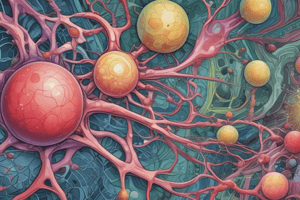Podcast
Questions and Answers
What are some functions of cells?
What are some functions of cells?
Destroy bacteria, gas exchange, make hormones, clean the blood.
What are the three main parts of a cell?
What are the three main parts of a cell?
The nucleus, cytoplasm, and outer plasma (cell membrane).
What is the cell membrane?
What is the cell membrane?
An extremely thin and selectively permeable structure.
What is the function of the cell membrane?
What is the function of the cell membrane?
What is the basic structure of the cell membrane?
What is the basic structure of the cell membrane?
What does the cytoplasm contain?
What does the cytoplasm contain?
What is the endoplasmic reticulum?
What is the endoplasmic reticulum?
Why is rough ER rough?
Why is rough ER rough?
Why is smooth ER smooth?
Why is smooth ER smooth?
Where are ribosomes found?
Where are ribosomes found?
What are ribosomes composed of?
What are ribosomes composed of?
What do ribosomes help produce?
What do ribosomes help produce?
What is the Golgi apparatus composed of?
What is the Golgi apparatus composed of?
Why would a cell want to go into the Golgi apparatus?
Why would a cell want to go into the Golgi apparatus?
What is the role of mitochondria?
What is the role of mitochondria?
What do lysosomes contain?
What do lysosomes contain?
What do peroxisomes contain?
What do peroxisomes contain?
What are microfilaments and microtubules?
What are microfilaments and microtubules?
What is the function of the centrosome?
What is the function of the centrosome?
What are cilia and flagella?
What are cilia and flagella?
What is the only flagellated cell in the body?
What is the only flagellated cell in the body?
What are vesicles?
What are vesicles?
What is the nucleus?
What is the nucleus?
What is the nucleolus made up of?
What is the nucleolus made up of?
What is chromatin made up of?
What is chromatin made up of?
How does the cell membrane control movement?
How does the cell membrane control movement?
What is passive transport?
What is passive transport?
Where does the energy for passive transport come from?
Where does the energy for passive transport come from?
What is diffusion?
What is diffusion?
What substance is moved by osmosis?
What substance is moved by osmosis?
What substances diffuse in the human body?
What substances diffuse in the human body?
What pressure results from osmosis?
What pressure results from osmosis?
Flashcards are hidden until you start studying
Study Notes
Cell Functions
- Cells perform various functions including destroying bacteria, gas exchange, hormone production, and blood cleansing.
Basic Structure of Cells
- A cell comprises three main components: the nucleus, cytoplasm, and plasma membrane.
Cell Membrane
- The cell membrane is extremely thin and selectively permeable.
Functions of Cell Membrane
- It regulates substance movement in and out of the cell, participates in signal transduction, and helps cells adhere to one another.
Structure of Cell Membrane
- The membrane consists of a phospholipid bilayer, with fatty acid tails facing inward, and includes transmembrane and peripheral proteins.
Cytoplasm
- Comprises cytosol (a clear liquid), a supportive cytoskeleton, and networks of organelles and membranes.
Endoplasmic Reticulum (ER)
- It is formed of membranes and provides a tubular transport system within the cell.
Rough vs. Smooth ER
- Rough ER is ribosome-studded, aiding in protein transport; Smooth ER lacks ribosomes and is involved in lipid transport.
Ribosomes
- Ribosomes are found floating freely in the cytoplasm or attached to membranes and are made up of proteins and RNA, vital for protein synthesis.
Golgi Apparatus
- Composed of flattened membranous sacs, it packages cellular products for transport outside the cell.
Mitochondria
- Known as the cell's powerhouse, mitochondria contain enzymes crucial for aerobic respiration.
Lysosomes
- Contain digestive enzymes to break down old cell components and bacteria, often referred to as the cell's garbage disposals.
Peroxisomes
- House enzymes for bile acid synthesis, lipid breakdown, rare biochemical degradation, and alcohol detoxification.
Microfilaments and Microtubules
- These threadlike structures make up the cytoskeleton; microfilaments of actin aid in cellular movement, while microtubules are formed from tubulin.
Centrosome
- Comprised of two hollow cylinders called centrioles, it helps ensure correct chromosome separation during cell division.
Cilia and Flagella
- Cilia are shorter motile extensions, while flagella are longer; both assist in moving substances across the cell's surface.
Vesicles (Vacuoles)
- Formed from the ER or Golgi membrane, vesicles store various materials.
Nucleus
- Surrounded by a double-layered nuclear membrane with larger pores for transport of substances.
Nucleolus
- Located within the nucleus, made up of protein and RNA, it is responsible for constructing ribosomes.
Chromatin
- Composed of DNA and protein, it is part of the nucleus' structure.
Passive Transport
- Movement mechanisms across the membrane that do not require energy include diffusion, facilitated diffusion, osmosis, and filtration, driven by a concentration gradient.
Diffusion
- The process where substances move from an area of higher concentration to an area of lower concentration until equilibrium is reached.
Osmosis
- Only water is transported via osmosis, a specific type of diffusion.
Substances Diffusing in the Body
- Oxygen and carbon dioxide primarily diffuse across cell membranes.
Osmotic Pressure
- The pressure resulting from osmosis, important in maintaining cell volume and function.
Studying That Suits You
Use AI to generate personalized quizzes and flashcards to suit your learning preferences.




